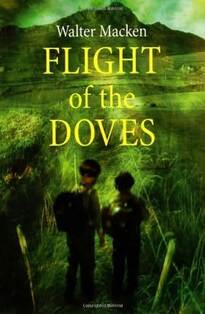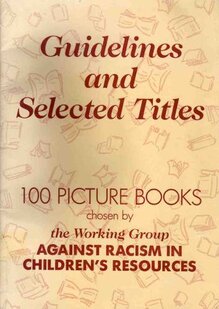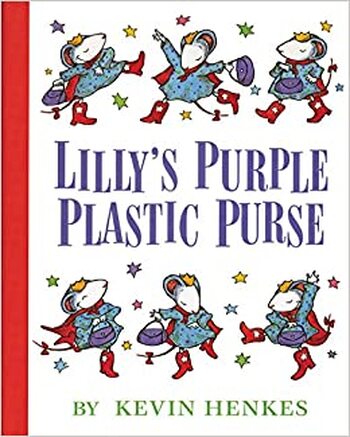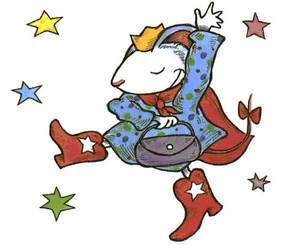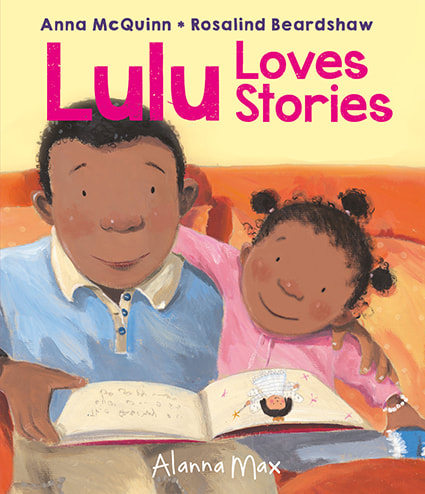Who gets to hold the purple plastic purse?
Beyond Inclusion in Children's Picture Books
Boys and girls, of different abilities and from different races and cultures need to see themselves included in the books that they read – if they are not good enough to be in books, they get a message that they are not good enough for the world. But inclusion is not enough – they can’t just be in the background, and they certainly should be there just to teach the mainstream about prejudice. They need to be the stars – they need to be the ones who hold the purple, plastic purse.
I learned to read very early and was a voracious reader – I don’t know what age I was exactly, but I must have been quite young to be such a fan of Enid Blyton’s Mr Pinkwhistle! I was given The Naughtiest Girl in the School as a present and, because I didn’t know how such books worked, I read it the same way as I did Mr Pinkwhistle – choosing a random chapter to start off with then another… It was incredibly confusing and the ‘stories’ didn’t make any sense and were all about a girl called Elizabeth, but I couldn’t work out what was going on! I must have read about four chapters before I realised that it was one long story and had to start at the beginning and read all the way through – which was rather spoiled by the fact that I’d already read the penultimate chapter!
Once I got my head around it, I really enjoyed this new format and getting my teeth into longer stories – more Naughtiest Girl stories followed, then the St Clare’s series, Malory Towers, the Five Find-Outers, the Adventure of Spiggyholes, the Famous Five and Mr Galliano’s Circus . I just ate them up.
The books were full of girls called Felicity and Gwendoline and Penelope – playing lacrosse, eating cress sandwiches, radishes and drinking ginger beer. Growing up in rural Ireland in the 1970s, I had never met anyone called Gwendoline or Penelope (in fact I'd never heard anyone say the names aloud so I had my very own pronounciation for them!) and I had no idea what cress was - I even got some radish seeds and grew them one summer just to find out (reader, I did not like them). I was shocked that the children were allowed drink Ginger Beer as I assumed it was alcoholic…
but I adored the books anyway and read and re-read them endlessly.
I learned to read very early and was a voracious reader – I don’t know what age I was exactly, but I must have been quite young to be such a fan of Enid Blyton’s Mr Pinkwhistle! I was given The Naughtiest Girl in the School as a present and, because I didn’t know how such books worked, I read it the same way as I did Mr Pinkwhistle – choosing a random chapter to start off with then another… It was incredibly confusing and the ‘stories’ didn’t make any sense and were all about a girl called Elizabeth, but I couldn’t work out what was going on! I must have read about four chapters before I realised that it was one long story and had to start at the beginning and read all the way through – which was rather spoiled by the fact that I’d already read the penultimate chapter!
Once I got my head around it, I really enjoyed this new format and getting my teeth into longer stories – more Naughtiest Girl stories followed, then the St Clare’s series, Malory Towers, the Five Find-Outers, the Adventure of Spiggyholes, the Famous Five and Mr Galliano’s Circus . I just ate them up.
The books were full of girls called Felicity and Gwendoline and Penelope – playing lacrosse, eating cress sandwiches, radishes and drinking ginger beer. Growing up in rural Ireland in the 1970s, I had never met anyone called Gwendoline or Penelope (in fact I'd never heard anyone say the names aloud so I had my very own pronounciation for them!) and I had no idea what cress was - I even got some radish seeds and grew them one summer just to find out (reader, I did not like them). I was shocked that the children were allowed drink Ginger Beer as I assumed it was alcoholic…
but I adored the books anyway and read and re-read them endlessly.
|
Then I was given a book called Flight of the Doves (1968).
It’s about a boy called Finn and a girl called Derval. The children run away from an abusive uncle to find their granny in Galway. Well, when I came to that bit, I was so excited. Galway! I’d heard of Galway - it was real. I might even have been there. To this day I remember how the world shifted on its axis as I read this book. Suddenly the world inside the book was real and tangible and meaningful. Children like me were IN it. I read the book 40 years ago - I even had to search Google to get the title - but I can still remember clearly that the girl cut her hair and pretended to be a boy so people looking for the children wouldn’t recognise her and take her back. I remember a bit where they were helped by a Minceir family and how kind they were. I remember it like it happened to me. Suddenly books were something I was IN! |
So when I write or publish books with little assertive girls or black boys or naughty frogs or grumpy bears, it’s not to fight racism or strike a blow for feminism or counter disabled stereotypes or promote empathy - though, of course, I hope it will do all those things.
The driving driving force is to make sure all children see themselves IN books - it’s that simple. Books show children the world and they need to see themselves in books to know they have a right to be in the world.
For me, therefore, it is important that the children’s stories I write and publish
include all sorts of different children but not be about difference.
|
Between 1990 and 1997 I was an active member of The Working Group Against Racism in Children's Resources.
The Book Group sub-committee met regularly and one discussion stands out to me and made me sensitive to this subtle but vital difference. The book we were discussing was about a little boy called Tariq who was the only Asian boy in his school and was struggling to fit in. To make a long story short, he turned out to be a great swimmer, made the school swim team and in a stunning climax, represented the school in a county championship. Of course this really challenged his racist schoolmates, who began to realise that he wasn’t really different after all. And at the end, in an emotional scene they cheered for him to win on behalf of the whole school... |
On the face of it, this seemed a positive story: it showed children they shouldn’t judge those who seem different; it included an Asian boy and told a positive story of how he used his talents to triumph over racism. But, as one of our group pointed out - why did he have to be the one to do something to make the other boys change their views? Why was it his responsibility to educate them? And why did he have to prove himself worthy in some way?
This was a pretty crude story (though there are lots of the same about) with an unsubtle message that being racist is wrong. But what I began to appreciate during our discussion was two huge issues:
The white reader
I realised that this book, like many ‘inclusive’ books, was written with a view of teaching white child readers not to be prejudiced – against people of a different race, religion, culture or ability. The readers are envisaged as white children who learn from the story to be less judgemental of ‘different’ others and perhaps to show empathy to people not like themselves.
It seems to me that the writer at no point envisaged a situation where the reader could be an Asian child. In fact, if you were an Asian child reading this and you couldn’t swim, would you be really scared of moving to a new school? Isn’t that message coming through - if you are from some minority group you’d better have some special talent or you’re suckered! I realise I’m being facetious here but really!
The isssue
So it follows that the only reason the Asian child got to be in the book was to teach white children about racism and prejudice.
It didn't seem possible to have a story that featured an Asian child and not have the plot focus on racism or prejudice.
And if that’s the message from the world in the book, that’s the message in the world! That is a pretty shameful message!
This was a pretty crude story (though there are lots of the same about) with an unsubtle message that being racist is wrong. But what I began to appreciate during our discussion was two huge issues:
The white reader
I realised that this book, like many ‘inclusive’ books, was written with a view of teaching white child readers not to be prejudiced – against people of a different race, religion, culture or ability. The readers are envisaged as white children who learn from the story to be less judgemental of ‘different’ others and perhaps to show empathy to people not like themselves.
It seems to me that the writer at no point envisaged a situation where the reader could be an Asian child. In fact, if you were an Asian child reading this and you couldn’t swim, would you be really scared of moving to a new school? Isn’t that message coming through - if you are from some minority group you’d better have some special talent or you’re suckered! I realise I’m being facetious here but really!
The isssue
So it follows that the only reason the Asian child got to be in the book was to teach white children about racism and prejudice.
It didn't seem possible to have a story that featured an Asian child and not have the plot focus on racism or prejudice.
And if that’s the message from the world in the book, that’s the message in the world! That is a pretty shameful message!
|
One of my favourite stories (as an adult – sadly it was not around when I was a child) is Lilly’s Purple Plastic Purse (1996) by Kevin Henkes. It’s about a girl (mouse) who loves school and adores her teacher. One Monday she brings her new purple plastic purse to show everyone but can’t hold on until Sharing Time – which lands her in trouble with her beloved Mr Slinger. I see so much of my child self in Lilly and I use her story as my guide when I’m writing. My question is not, “What would Jesus do?”, but “who gets the purple plastic purse?” Who gets to hold the |
|
It’s an excellent question to ask of any story and any character...
If there’s a story and there’s a little girl in a wheelchair – does she get to have the purple plastic purse? In other words, she needs to be the centre of the story for some reason other than her wheelchair. If she’s not holding the purple plastic purse, then why not? It’s not enough for her to be there in the background of someone else's story so we can all feel good about being ‘inclusive’ and she certainly can’t be there to teach an able-bodied child not to be prejudiced. It needs to be a story about her fabulous, purple plastic purse! |
|
Lulu Loves Stories (2009) is a very simple story for pre-schoolers about a little girl who loves books and acts out the stories she reads. Lots of people are delighted that the heroine is a little Black girl and that her race is not an issue in the book – she is in there simply because she loves stories. However, it always amazes me that some people still ask why I chose to make the little heroine Black – like she needs a reason to be there.
For me, the fact that race is not an issue is the whole point! Thinking about the reader - especially Black children, girls or disabled readers – how excruciatingly boring it must be if the few books you see yourself in are about issues and triumphing over adversity. Don’t you think you’d ache for a story about a birthday party or an adventure or something fantastical… And while there is an important place for books that raise consciousness or teach tolerence, it is positive that we are moving towards a place where we include a diverse range of characters, backgrounds and experiences in EVERY story. |
However, we need to take care that any celebration of diversity doesn't overly focus on what makes us different and become preoccupied with difference.
One if the things I notice when I work directly with children is how alike they are*. All the studies point to the fact that we are more like our peers than our families, but it is when you see children together that you realise how much they have in common. Especially in school and in the playground, even children from vastly different backgrounds have many of the same preoccupations and aspirations. They are as likely to identify in terms of who wants which person to win ‘Strictly’ as they are along lines of religion or race. So we must be wary of putting too much emphasis on difference – even if it is by way of celebration. There is a danger in making difference exotic and 'other' and finding ourselves back in a place where difference separates us rather than being just a part of the rich fabric of life.
And so, for me, the best stories focus on common anxieties experienced by all children and the very best stories include different children as they work out who they are and how they fit in the world – and whether they ever get to hold the purple plastic purse!
Anna McQuinn 2013
And so, for me, the best stories focus on common anxieties experienced by all children and the very best stories include different children as they work out who they are and how they fit in the world – and whether they ever get to hold the purple plastic purse!
Anna McQuinn 2013
And if you are looking for more writing on this topic can I recommend the following:
|
*This is not to say that children are 'colourblind' or that I'm saying we should be colourblind - that's a separate conversation! If you want to read about that topic, these are excellent:
When you say you 'don't see race', you're ignoring racism by Zach Stafford in The Guardian - here 7 Reasons why 'Colorblindness' Contributes to Racism by Jon Greenberg in Everyday Feminism - here Colorblind Ideology is a form of Racism by Monnica T Williams in Phychology Today - here |
On 'natural inclusion'
Nobody puts it better than Rumaan Alam in Slate Magazine We Don’t Only Need More Diverse Books. We Need More Diverse Books Like The Snowy Day. One of my favourite articles which really says everything I've ever wanted to say on the subject of 'natural inclusion' but eloquently! 28 Black Picture Books that are not about Boycotts, Buses or Basketball by Scott Woods The first in a series on Scott Woods Makes Lists Writing Past The White Gaze As A Black Author by LJ Alonge - Super super article Diverse Books: Don't Categorize as "Special Interest" by Ellen Oh in School Library Journal |
